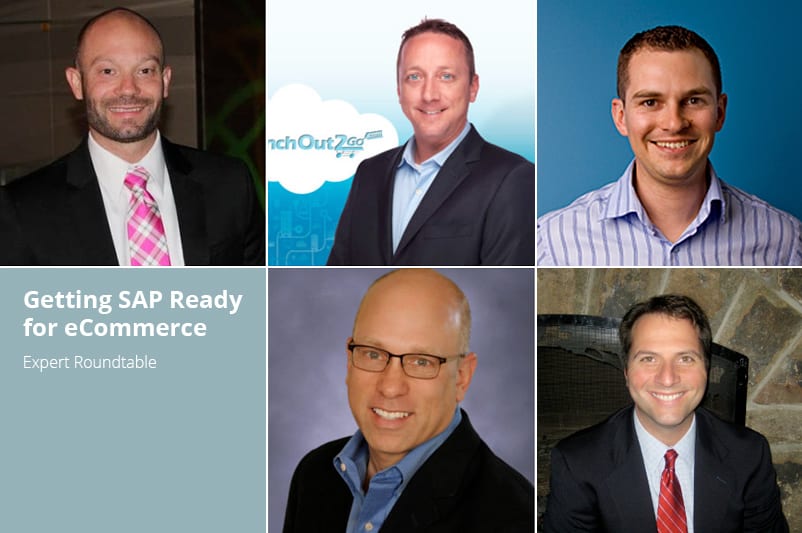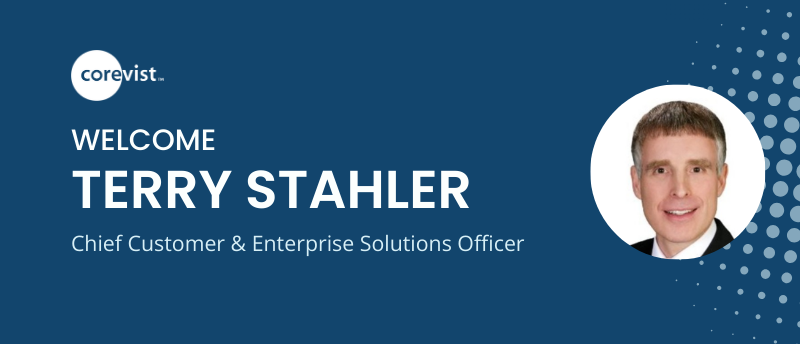Share
Author
George Anderson
Share
SAP e-Commerce Preparation: The Ultimate Guide
Last updated: 2/27/18
How can CIOs build a powerful SAP e-commerce solution that meets the unique needs of their business efficiently? It may seem like a daunting task, but the key is to break it down. Focus on the big issues first. The rest will come out in the wash. Because a Magento SAP integration is a powerful, cost-effective solution, we asked Peter Sheldon, VP of Magento, for his thoughts on the subject. We also brought 4 other SAP commerce experts to the roundtable discussion.
We started with a simple question:
“What advice would you give the CIO who is about to embark on an SAP B2B e-Commerce project and has you on their team?”
Click to read their thoughts below:
1. Magento as B2B e-Commerce Platform: Peter Sheldon, VP Strategy, Magento
2. Choose a Trusted SAP e-Commerce Advisor: Damian DellaVecchia, VP Client Services, Corevist
3. Considering Payments from the Start: David Curl, Dir. Enterprise Accts., CardConnect
4. Product Configurators for B2B e-Commerce: Scott Perdue, President, ConfigIt
5. Connecting eCatalogs to eProcurement Systems: Brady Behrman, CEO, PunchOut2Go
1. Peter Sheldon, VP Strategy, Magento:
When it comes to picking a platform to do SAP B2B commerce, it’s all about fit. You should have the courage to pick the solution that’s right sized for your business today. If you’re a mid-market firm, it’s important to have a realistic outlook on your maturity level in B2B commerce and to consider the trade-off’s associated with a complex all-in-one solution. Too often B2B firms end up selecting a commerce platform that is simply overkill for their needs. The result is budget overruns, late project delivery and worse still, a platform that is simply too complex for the purpose, bogging down agility and growth of the online channel while bloating operational costs. B2B firms often end up in this position due to political relationships with their incumbent ERP provider and commercial pressures to adopt the ERP vendor’s in-house commerce platform.
For firms using SAP ERP, hybris is the defacto solution for B2B commerce and in a large, complex, multi-billion dollar conglomerate, it’s probably the right fit. But what about those mid-market firms or “in-the-family” B2B manufacturing companies? How much does hybris off-the-shelf functionality map to the business needs of mid-sized firms? When you consider that 83% of companies who opt to develop software in-house do so because of mismatched functionality in packaged software – either because packaged software has too many features that they don’t require (47%), or it doesn’t have functionality that they do require (36%)*, it’s important to ensure a solution is right for your business.
Many B2B companies are still in the first stage of commerce maturity. Perhaps they’ve had some legacy, online ordering mechanism that was built 10 years ago. Often manufacturers are reacting to something that their competitors have done or because they see an opportunity to leap ahead of their competition. They don’t have a huge budget to invest because the Board is still skeptical. They want to prove to the C-suite that digital is something to invest in, so agility and time to market are essential. They need to innovate quickly to roll out digitized product discovery and digitized ordering experience. Everyone is looking for a quick win.
Magento offers the best of both worlds: robust out of the box capabilities, coupled with unrivaled flexibility to customize and extend the functionality you need as your digital business grows. Our 3,900-strong global ecosystem of partners and extension providers ensures that you have unrivaled choice and speed to market. It enables you to get your B2B e-Commerce store up and running fast, and to show success!
It really comes down to agility, flexibility, time to market, and cost of ownership. These are the advantages which Magento offers for SAP e-Commerce.
*Source: Gartner, User Survey Analysis: Digital Commerce Platform Growth Trends and Directions, 2017, Yanna Dharmasthira, January 27, 2017
ABOUT THE AUTHOR
Peter is a well-known industry expert in eCommerce and omnichannel technology, having previously held the role of Vice President and Principal Analyst at Forrester Research where he spent 5 years leading Forrester’s global research on digital commerce technologies, helping to challenge the thinking and lead change for eCommerce executives undertaking major digital transformation and commerce technology programs. Today, Peter leads corporate strategy and business development for Magento.
2. Damian DellaVecchia, VP Client Services, Corevist:

Consider ROI, change management, and “the soft stuff”
From a high level, consider your total cost of ownership and your return on investment. Your ROI will be based on the efficiency of your current business processes and solution within SAP, and web-enabling them for your customer base.
Zooming in a bit, I suggest you really focus on the soft stuff–the change management piece. Rolling out your eCommerce solution, marketing it to your customers, and explaining the benefits of these self-service tools are all critical to success. The soft stuff is the hardest part of the project.
When you focus heavily on the soft stuff internally, that allows Corevist to focus on the heavy lifting in the integration world. It makes for a great partnership between us and you.
When you think about this, the cost to implement–it’s a capitalized expenditure. You can depreciate it over some number of years. All you need to worry about is this overhead operating expense, which might be roughly equivalent to the salary expense of one CSR. But one CSR can’t manage the sales volumes that you’ll be running through our environment. It’s a no-brainer to move forward with this kind of solution.
Start getting your SAP house in order
My other piece of advice is, start to get your SAP house in order first–but don’t become a perfectionist about it. As we say at Corevist, “Pursue Perfection Pragmatically.” In other words, do everything you can to get SAP ready–but don’t let a work-in-progress delay the eCommerce discovery process. Get your business processes, your master data, and your technical SAP installation working like a well-oiled machine. Make sure that your SAP is stable. I can’t emphasize that enough. Then, when you expose that well-oiled machine to the web and to your customers, there’s no fear. You have started to get your SAP house in order.
As a side note, we sometimes get a lead who is in the market for our solution but is doing a big SAP implementation at the same time. It’s never a good idea to do that. You need to establish your SAP first and stabilize it. Once you do that, you’re ready to put an eCommerce website over top of your SAP environment. But you can’t put the cart before the horse.
Once you have your SAP house in order, you can turn it over to the Corevist team for heavy lifting with the integration. Then we turn it back to you to do the soft stuff–the marketing piece, rolling it out to your customer base. We manage this shift of responsibilities gradually, through a progressive series of focus groups. At the end of the project, your team is well equipped to promote the new eCommerce website to your customer base.
Keep your best CSRs and evolve their duties to include eCommerce website management
CIOs should also consider how the new eCommerce website will affect the customer service organization. The website will free up time for CSRs. This may mean downsizing, partial reassignment of duties, or some combination of the two. If you’re really lucky, you’ll be able to handle your growing business without adding any staff. Think of ways that you can repurpose the skills of your best CSRs to serve your customers in an eCommerce environment.
CIOs also need to understand the ongoing nature of the eCommerce project. The fact that we’re going to deliver this eCommerce window on top of their SAP environment doesn’t mean the project stops there. It’s a process of continuous improvement. Make sure you’ve earmarked a person or group who is going to shepherd this solution for the lifecycle of the application. In other words, the project doesn’t stop once we go live. You’ll want to continually monitor, manage, and maintain it.
The CSR is ideally positioned for this role since they’re not taking phone calls all the time.They can help pull the customer’s request feedback and continually improve the application.
Don’t be afraid to talk to us about custom functionality
I’d also encourage the CIO to help us deliver solutions that aren’t already in our stack but are possible. We can co-develop them. It’s a great way for us to drive innovation within our company internally, and it helps us provide better solutions to you and all other clients. If you have custom integration needs within your CRM application, for instance–let us integrate that. It builds efficiency in both our companies.
Partner with a trusted advisor for long-term success
Look to us as a trusted advisor to help you evolve as your business evolves. We advise you on how to utilize this eCommerce solution to enable your growth.
Given the tight integration that we have, we are a great partner. Plus we have tons of SAP experience on how to run an implementation. You don’t just stop at the go-live. In order to get return on investment, to capitalize on total cost of ownership, think broadly in terms of rolling it out to all customers. You want to get as many customers as possible off phone, fax, and email. Put one internal person in charge of embracing the tool and expanding its use. Put goals and incentives in place to reach your rollout objectives. Leverage the eCommerce solution.
But like anything in life, you can build something as sexy as you want. If people don’t use it, it’s not worth it. We’ve had clients like that. We built a great site for one client. They never used it. Now they’re turning off the service. They had a specific niche and a need to build it for a potential customer that they were signing up. They built everything. The customer signed up with them. They used it sparingly, nowhere near to the extent it could’ve been used. But it was worth it. The value of acquiring that one new customer far exceeded the cost of our implementation.
Look for proven results and deep SAP experience
One more thing: don’t buy a custom solution. Ours is an off-the-shelf solution that we’ve refined over the course of 9 years and 23 clients. Yes, we do expand it each time. But this product is 23 clients deep. As each client asks for new features, those features will be rolled out in our core product, and you’ll benefit from that. It’s not a one-time solution. It’s an evolving, ever-changing, innovative application.
With Corevist, you’re also buying deep, deep SAP and eCommerce experience. You can’t replicate that anywhere else. Anyone can build something, but most people don’t know where to house the processes. SAP? Middleware? The web? We know, and we do it scalably. That makes all the difference.
ABOUT THE AUTHOR
Damian has over 20 years of experience in the SAP world. He has held titles such as SD Configuration Consultant, SAP Integration Lead, Product Manager, and Engagement Manager. Having founded his own SAP consulting business, Confide IT, he brings a rich understanding of SAP functionality and clients’ unique needs to the table. As VP of Client Services at Corevist, Damian oversees every SAP B2B e-Commerce implementation we do, matching each client’s unique business needs to the flexibility and functionality of the Corevist solution.
3. David Curl, Dir. Enterprise Accts., CardConnect
Since CardConnect is a payments company that specializes in SAP integrations, my advice would be to map out your payment security strategy as early as possible. The biggest security and complexity issues I see many organizations run into, arise when a business tries to fit a credit card integration into an eCommerce project that has already taken flight. Credit card acceptance and integration isn’t always standard. There are many decisions to be made, some of which are dictated by business, some by technology and others by security. Many of these decisions could have very significant PCI Compliance ramifications.
Some of the things you will need to consider are while you are mapping out your strategy are the card types and currencies you want to accept as well as what payment types (credit cards, PayPal, ApplePay, etc.). You will also need to specify the transaction flow. For example, do you need real time authorizations and do you want them to initiate from SAP or from your web servers? Is one vendor that can provide an end to end solution (web/SAP integration, tokenization and processing) right for you, or does your business require multiple vendors? Security adds many important planning decisions as well. Are you going to use tokens or encryption (tokens are much more secure)? Will you store the cards internally or use a 3rd party? Do you have an internal team to manage PCI Compliance or are you going to outsource it?
At CardConnect, our recommendations are driven by the business and security needs of our customers. These drivers are discovered in planning sessions before the actual work commences. When it comes to security, we recommend 3rd party tokenization where the card numbers are tokenized before they ever touch your environment (web servers or SAP). This will not only increase the protection of your customers’ credit card data, it will help minimize your PCI footprint and save you a great deal of money, time and effort in the long run.
Just remember the most important thing about integrating payments into your eCommerce project is making sure you account for it during your planning and blueprinting phase. It is always much easier to put the whole solution together in the beginning rather than try to fit it in after your eCommerce architecture is already in place.
ABOUT THE AUTHOR
David Curl is the Director of Enterprise Accounts at CardConnect. He has more than 25 years of enterprise software experience, with a focus on Fortune 1000 companies, and more than a decade of work on credit card payment security and integration. Prior to his new role, Curl was the Vice President of Sales at enterprise payment solution provider Paymetric.
For more information, please contact David at:
DavidCurl
e dcurl@cardconnect.com
p 832.630.6886|
4. Scott Perdue, President, ConfigIt, Inc.

Think about the growing role that product configurators will have in B2B e-Commerce. Take a product like a 10,000HP electric motor that costs $300-500k and takes a year to build. Traditionally, a product like this hasn’t been sold through eCommerce. It’s a big, heavy transaction, and the customer wants to talk to a human about it.
However, we’re seeing more and more product configurators moving online—even for big, expensive products like that electric motor. These configurators generally fall into two camps: either they allow a customer to configure a product and feed that data to an ERP as sales intelligence, or they actually allow a customer to configure a product and then click “order now.”
That second option is a big paradigm shift, and CIOs need to consider how this will affect their business.
We’re seeing this play out in the consumer auto market. It is not uncommon for a single automobile, offered globally, to have 1020+ possible buildable combinations. Most companies already offer a “build it now” configurator on their site that feeds a local dealer the configuration in the form of a “hot” lead.
But Tesla takes this a step further. You can actually go to Tesla’s website and buy one. You can configure your $100k car and click “order now.” That’s a huge shift in the industry, and it tells us a lot about Tesla and its customers. It means everyone feels comfortable ordering a $100k Tesla online. Customers and the manufacturer have confidence in the technology behind the configurator. Even more importantly, Tesla believes the customer will pay, and the customer believes that the car will get built.
Now, B2B manufacturers don’t have to make this shift overnight. We see it moving in stages. In the first stage, you use the configurator to let the customer configure the product how they want it. You feed that information to a salesperson, and he or she follows up with the customer and talks about the product that has been configured. This lets the salesperson build proposals and quotes, working with the customer to strike the right deal. This is the tradition when it comes to large, highly configurable products, and it’s still standard practice in the world of large B2B products.
In the second stage, as a manufacturer, you enable resellers and dealers to use the configurator. They’re still not ordering the product online—the sale still happens person to person, through the ERP. We have clients who’ve taken these configurators and dropped them into their dealer-facing websites. This allows dealers to configure products on their own, then get follow up communication from sales. In the second stage, you still aren’t letting people place orders from the configurator on the website.
The third stage is what Tesla is doing. Not only is the configurator available on your website, but you’re doing eCommerce, and the configurator lets a customer actually place an order for a complex product online.
Moving from configuring to ordering indicates a huge shift in the Engineering and Manufacturing processes. In order to offer an “order now” button, you’ve likely put enough confidence in the configurator to bypass an Engineering design of the configured product and taken the order straight to manufacturing. The presence of an “order now” button should be driven by advancements in your Engineering and Manufacturing processes, not the other way around.
It’s a pretty serious shift, and not every business needs to go all the way to stage 3. But CIOs should perform due diligence to uncover any market opportunities which may open up if they install a product configurator for their B2B e-Commerce store.
ABOUT THE AUTHOR
Scott Perdue is President of Configit, Inc based in Atlanta, Georgia. He has 19 years of Information Technology experience, including 10 years working with Configuration technologies in the context of PLM, ERP, and CRM systems. Configit A/S, headquartered in Copenhagen Denmark, is a global leader in Configuration Lifecycle Management (CLM) and Configure, Price, Quote (CPQ) solutions and a supplier of business-critical software solutions for the configuration of complex products. All Configit products are based on the patented configuration technology Virtual Tabulation™. This technology has redefined what is possible with configuration in terms of complexity and speed, and enables Configit to make software that can handle and utilize complex product configurations in a way that is both powerful to business and easy to use.
5. Brady Behrman, CEO, PunchOut2Go
As more buying organizations adopt eProcurement software such as Coupa, SAP Ariba, Oracle, Peoplesoft, etc. to automate and streamline the procure-to-pay process and manage spend, CIOs need to ensure that their organization has the best technology in place to connect their electronic B2B catalogs to their customers’ eProcurement systems with speed and precision and provide B2B order automation. Many organizations try to handle eProcurement integrations in-house but quickly uncover that no two integrations are the same and customization is required. Seeking help from a third party eProcurement integration partner, like PunchOut2Go, reduces the cost and complexity for Suppliers providing a scalable solution so they can accelerate their on boarding time, meet their eProcurement customers needs and capture ROI quickly.
Buying organizations leveraging eProcurement software require Suppliers to provide a PunchOut Catalog via their eProcurement system “marketplace” in order to display the proper product offering and pricing from an agreed upon contract. End users within the buying organization expect to be authenticated into supplier eCommerce applications to order from their preferred suppliers and expect a B2C shopping experience that is rich in images, product content and provides website features such as enhanced supplier specific search options, quick order, user favorites and a UI that best represents the suppliers offering. When implementing a B2B e-Commerce platform via SAP e-Commerce, it is important for CIOs understand their customers’ expectations and ensure that the platform will deliver on those expectations.
Connect your SAP e-Commerce application to your content management system. Displaying the correct product content and pricing within a PunchOut Catalog is critical and this will ensure that as new products are launched, prices change, etc the PunchOut Catalog will display the correct information to your customers.
ABOUT THE AUTHOR
With 20 years in the web development ecommerce industry, Brady Behrman co-founded PunchOut2Go in 2011 and quickly grew it into a global company. PunchOut2Go specializes in reducing the cost and complexity of B2B eProcurement integrations, enabling companies the ability to connect their eCommerce application to their Buyers on procurement systems such as Ariba, Coupa, SAP, Oracle, PeopleSoft and more in order to automate the procure to pay processes. Offering a platform-as-a-service gateway, PunchOut2Go supports thousands of integrations for companies in many industries around the world.
Moving forward: Case study
If you’re curious about SAP-integrated ecommerce and what it could mean for your organization, download this case study. You’ll learn about PARI Respiratory, a 106-year-old company that engaged Corevist Commerce to provide online B2B ordering for their customers. The best part? Marketing got the best-of-breed ecommerce experience they needed, and IT got total data integrity with SAP as the system of record.










